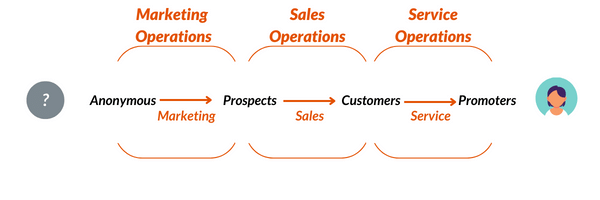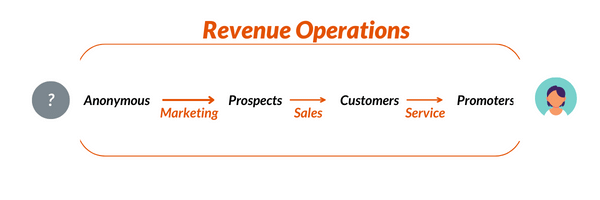What's New: HubSpot Product Updates for June 2023
From AI to app integrations, HubSpot's June updates do not disappoint. For the first time ever, we are thrilled to announce the inclusion of a public...

Today's most disruptive companies are winning on customer experience. Easily said, but difficult to achieve. A foundational ingredient of delivering a great customer experience is operational alignment. If you think holistically about how a business operates and generates money, three groups comprise revenue generation and retention activi. They are marketing, sales and service. The concept that all three work in a coordinated and aligned fashion, instead of siloed and in isolation from each other, is what is known as Revenue Operations (RevOps).
This isn't your traditional, outdated approach to revenue generation. Old school business management creates strictly diversified departments. By contrast, RevOps brings together multiple facets of a business to drive revenue with efficiency and focus.
Sales and marketing alignment has always been a hot topic and difficult to achieve for many businesses and is especially important for B2B companies. Many organizations struggle to get sales and marketing working together. The most common reasons are that the teams operate with different objectives or goals and use disparate systems that don’t talk. Even if your sales and marketing teams work well together, there is generally a need to be more intentional with communication, accountability and strategy.
It is also essential to acknowledge that the customer service team is often not considered a critical piece of the puzzle when looking at revenue generation. For many B2B organizations, there is a disconnect between “sales and marketing” and the handoff to customer success.
If you take a step back and look at these three teams, traditionally very separate departments, it becomes clear that when they work successfully together, business moves forward, and the customer’s journey is smoother.
 A significant hurdle for many businesses when looking to align the three teams is their technology stack. The only way to truly have synergy between the teams is to work from transparent or fully available data. Traditionally sales, marketing and service teams work in entirely different systems, with limited access to cross-departmental notes, which creates silos, frustration and confusion. Operational tech debt is extraordinarily painful and time-consuming. Operations folks are left to figure out priorities, put out fires, untangle systems and retrace steps.
A significant hurdle for many businesses when looking to align the three teams is their technology stack. The only way to truly have synergy between the teams is to work from transparent or fully available data. Traditionally sales, marketing and service teams work in entirely different systems, with limited access to cross-departmental notes, which creates silos, frustration and confusion. Operational tech debt is extraordinarily painful and time-consuming. Operations folks are left to figure out priorities, put out fires, untangle systems and retrace steps.
But there is a better way!
When you start viewing your business through a comprehensive operations lens, you will take steps toward achieving less friction between your teams and capitalizing on a more successful strategy.
Revenue generation is much more than a business's products and services. Driving revenue is the result of a carefully planned business model that includes all facets of a buyer's journey, from marketing to sales to customer service.

RevOps doesn't consider revenue generation exclusive to any one of these "departments." Rather than wearing a hat for marketing, a different hat for sales, and another for customer service, RevOps approaches business operations as the dynamic composite of all three departments.
Simply put, RevOps is the art of creating alignment between departments to automate processes where possible, eliminate redundancies and drive growth.
Let’s take a closer look at the three pieces of RevOps.
Marketing handles the first stage of the buyer's journey.
Meaningful engagement leverages your organization's processes, technology and people to develop a targeted approach to outreach or inbound communication. This means you'll attract your prime demographic without wasting resources on broad-based marketing strategies. In fact, 74 percent of organizations rely on inbound marketing tactics, with 53 percent reporting higher ROI with this strategy.
Of course, we traditionally think of sales as the core driver of revenue.
The sales funnel is typically considered separate from marketing and customer service. Many businesses focus too much on sales as the primary source of revenue. However, without marketing fueling engagement and customer service fueling retention, having a dynamic sales strategy is not enough to meet long-term revenue goals.
It is estimated that a sales rep only spends around 30% of their time actively selling. With an effective RevOps system, many administrative tasks, tracking and reporting can be automated. This will help your sales team spend more time making meaningful contact with leads and less time on non-revenue generating activities.
Great people are the number one reason most customers are loyal to a business, and exceptional customer service builds trust in your brand and adds a human touch.
Grand View Research found that the customer experience management market worldwide was worth as much as $7.6 billion in 2020. Furthermore, 84 percent of consumers consider customer service a key factor when deciding whether to purchase. Only three percent say it's unimportant.
As the market continues to expand, ensuring your customer service team can keep up is the best way to secure future revenue. That means hiring the best people and providing a great workplace culture (even in the virtual world).
In addition, you must consider the customer experience across all departments to drive revenue. This means changing your culture and utilizing technology to unify all three teams.
With an understanding of the three pieces of RevOps, it's time to consider implementing a dynamic, evolving revenue alignment strategy for your business. The first step to revenue alignment is auditing each of the three components and discovering areas for improvement. Consider each stage in the customer journey rather than simply auditing each in isolation.
Next, jump into action! Identify areas where automation can reduce time-intensive tasks or create a better customer experience. Identify clear processes for handoffs between marketing, sales and customer service. Look for overlapping processes or inconsequential reporting in different departments. Think about the communication your customer receives throughout their entire engagement with your organization and identify data silos between each stage. Optimize each area through collaboration with key players in your organization, look for improvement and expansion, and watch your business thrive. And maybe most importantly, review your technology stack.
You can better align your revenue operations if you leverage a tool like HubSpot. If you are not currently leveraging a tool like HubSpot, maybe you should!
Learn more about igniting your business with the RevOps experts at Inbound Ignited.

From AI to app integrations, HubSpot's June updates do not disappoint. For the first time ever, we are thrilled to announce the inclusion of a public...

In today's business world, collaboration among team members is essential for success. That's why HubSpot's May updates offer additional ways to...

Sometimes it's the little things that make a big difference. In April HubSpot made several updates that seem small on the surface, but these changes...